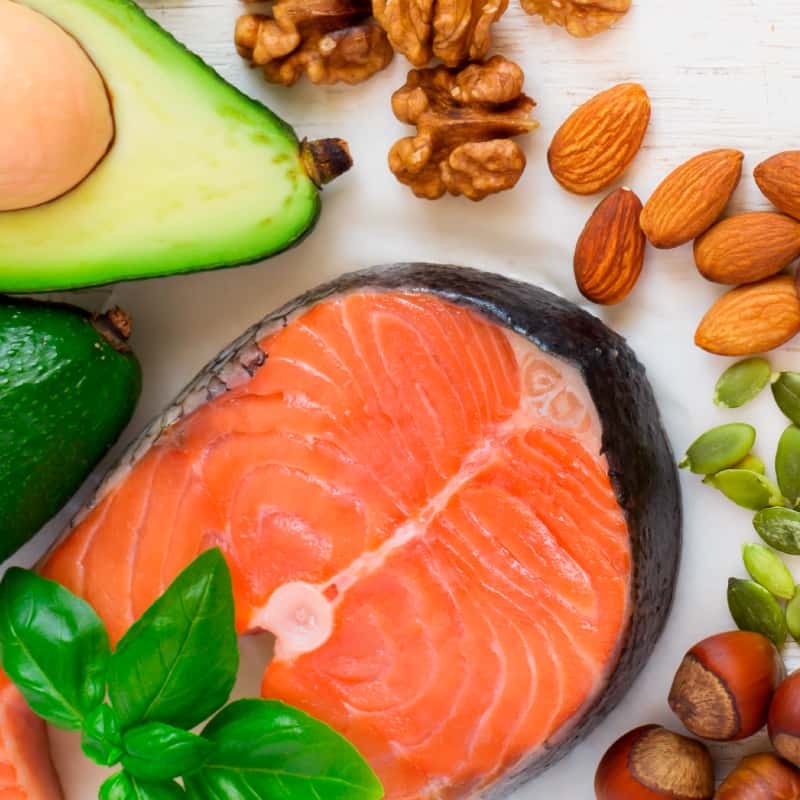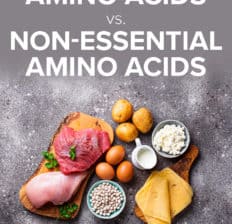This Dr. Axe content is medically reviewed or fact checked to ensure factually accurate information.
With strict editorial sourcing guidelines, we only link to academic research institutions, reputable media sites and, when research is available, medically peer-reviewed studies. Note that the numbers in parentheses (1, 2, etc.) are clickable links to these studies.
The information in our articles is NOT intended to replace a one-on-one relationship with a qualified health care professional and is not intended as medical advice.
This article is based on scientific evidence, written by experts and fact checked by our trained editorial staff. Note that the numbers in parentheses (1, 2, etc.) are clickable links to medically peer-reviewed studies.
Our team includes licensed nutritionists and dietitians, certified health education specialists, as well as certified strength and conditioning specialists, personal trainers and corrective exercise specialists. Our team aims to be not only thorough with its research, but also objective and unbiased.
The information in our articles is NOT intended to replace a one-on-one relationship with a qualified health care professional and is not intended as medical advice.
Non-Essential vs. Essential Amino Acids + Benefits for Weight Loss, Muscle Gain and Even Mood
May 21, 2023

Protein is incredibly important when it comes to your health. It makes up the structure of your bones, muscles and skin, and it is used to build tissues and synthesize hormones, enzymes and neurotransmitters. Amino acids are the building blocks of protein, which is why getting enough essential amino acids in your diet is critical to maintaining optimal health and preventing protein deficiency.
What are amino acids, and how can you be sure you get the right mix to keep your body healthy? Here’s what you need to know.
What Are Amino Acids?
The official amino acids definition includes any organic compound that contains both a carboxyl and amino group. To put it simply, they are considered the building blocks of proteins.
For example, they make up a large portion of your muscles and tissues, and protein foods like meat, fish, poultry and eggs are composed of many different types of amino acids.
How many amino acids are there, and what is the role of amino acids? There are 20 amino acids in total, each of which plays a very specific role in the body and is distinguished by its respective amino acid side chains.
These amino acids are involved in almost every biological process and aid in:
- wound healing
- hormone production
- immune function
- muscle growth
- energy production
- and more
Your body needs all amino acids to function and thrive. Some can be produced in the body while others need to be obtained from food.
Getting enough through either dietary sources or supplementation can help enhance weight loss, preserve muscle mass, improve exercise performance, boost mood and promote better sleep.
Amino acids have an interesting and long history. Asparagine was the first amino acid to be discovered when it was isolated from asparagus nutrition by French chemists Louis Nicolas Vauquelin and Pierre Jean Robiquet in 1806.
Glycine, leucine and cysteine were soon found in subsequent years, and threonine, the last one to be discovered, was found in 1935 by William Cumming Rose, the same biochemist who also determined which are essential and how much the body needs to function and thrive.
In 1902, scientists Emil Fischer and Franz Hofmeister were the first to propose that proteins are composed of individual amino acids, hypothesizing that bonds are formed between the amino group of one amino acid and the carboxyl group of another, creating the amino acids structure known as a protein peptide.
In recent years, research has continued to unearth new ways that amino acids impact the body as well as a long list of potential benefits associated with supplementation, proving just how important these compounds can be to health.
Essential Amino Acids vs. Non-Essential Amino Acids
The 20 amino acids that your body needs can be further divided into two distinct categories: essential amino acids and non-essential amino acids.
Essential amino acids cannot be synthesized by the body, That means you must get them from food sources to help meet your needs.
How many essential amino acids are there? There are nine essential amino acids that you must obtain through the diet, including:
- Lysine: Lysine is necessary for growth and tissue repair as well as the production of several hormones, proteins and enzymes.
- Leucine: This essential amino acid is involved in protein synthesis, wound healing, blood sugar control and metabolism.
- Isoleucine: Research shows that isoleucine aids in detoxification, immune function and hormone excretion.
- Tryptophan: Tryptophan is one of the most well-known amino acids that increases levels of serotonin, a neurotransmitter that regulates mood, pain, appetite and sleep.
- Phenylalanine: This amino acid helps produce other amino acids as well as neurotransmitters like dopamine and norepinephrine.
- Threonine: Research indicates that threonine forms the foundation of connective tissues like collagen and elastin.
- Valine: Valine supports brain function, muscle coordination and calmness.
- Histidine: This amino acid maintains the health of myelin sheaths in the human body, which protects nerve cells against damage.
- Methionine: Research suggests methionine keeps skin elastic and helps strengthen the hair and nails.
Getting a good variety of amino acids in your diet is crucial to maintaining overall health. A deficiency in any of these key essential amino acids can cause serious side effects that affect nearly every aspect of health, including immune function, muscle mass, appetite and more.
In contrast, non-essential amino acids can be produced by your body, meaning it’s not as crucial to get them through the foods that you eat. There are a total of 11 amino acids that make the non-essential amino acids list, including:
- Arginine: Arginine stimulates immune function, fights fatigue and optimizes heart health. Creatine monohydrate is formed in the liver, pancreas and kidneys, mostly with the help of arginine, glycine and methionine.
- Alanine: Research suggests that alanine aids in metabolism and provides energy for muscles, brain and central nervous system.
- Cysteine: Cysteine is the main type of protein found in hair, skin and nails, and it is crucial for collagen production and skin health.
- Glutamate: This non-essential amino acid acts as a neurotransmitter in the central nervous system.
- Aspartate: Aspartate helps produce several other amino acids, including asparagine, arginine and lysine.
- Glycine: Glycine functions as a neurotransmitter to support brain health.
- Proline: Proline is found in collagen, which helps promote joint health, metabolism and skin elasticity.
- Serine: Serine is necessary for fat metabolism, immune function and muscle growth.
- Tyrosine: Tyrosine helps synthesize thyroid hormones, melanin and epinephrine.
- Glutamine: Studies indicate that glutamine supports many metabolic processes and provides energy for the cells in the body.
- Asparagine: Asparagine acts as a diuretic, and it optimizes brain and nerve cell function.
Some of the compounds on the amino acid list are also considered “conditionally essential.” That means they are usually not required by the body but may become essential under certain conditions, such as extreme illness or stress.
Amino acids can also be classified into other groups based on their structures and side chains, including:
- polar amino acids
- aromatic amino acids
- hydrophobic amino acids
- ketogenic amino acids
- basic amino acids
- acidic amino acids
Health Benefits
1. Enhance Weight Loss
Amino acids benefit weight loss by enhancing fat loss and preserving lean body mass. Supplementing with branched-chain essential amino acids, in particular, has been shown to be especially effective when it comes to weight loss.
Impressively enough, a study published in the Journal of the International Society of Sports Nutrition showed that consuming a supplement with branched-chain amino acids (BCAAs) while following an eight-week resistance training program led to significant increases in lean body mass and strength gains, plus greater decreases in percent body fat than consuming a whey protein supplement or sports drink. However, other research has turned up mixed results, indicating a need for additional studies in the future.
2. Preserve Muscle Mass
As the primary building blocks of muscle tissue, amino acids are absolutely essential to muscle maintenance and muscle growth. Plus, some studies have found that supplementing with essential amino acids can help prevent muscle loss, which is a common side effect that occurs with both aging and weight loss.
For instance, a 2010 study published in the journal Clinical Nutrition found that supplementation with essential amino acids helped improve muscle function for older adults on bed rest. Similarly, a study out of South Carolina found that supplementing with essential amino acids was effective at preserving lean body mass while promoting fat loss in athletes.

3. Improve Exercise Performance
Whether you’re a casual gym-goer or a competitive athlete, essential amino acids are definitely necessary if you’re looking to bring your workout to the next level. In fact, essential amino acids like leucine, valine and isoleucine are commonly used to help promote muscle recovery, prevent soreness and fight fatigue as part of a healthy, post-workout meal.
One large review of eight studies found that supplementation with BCAAs was able to reduce muscle soreness and improve muscle function following intense workouts. Another study conducted by Leeds Metropolitan University found that taking four grams of leucine daily helped enhance strength in men during a 12-week resistance training program.
Additionally, a 2020 study published in Clinical Nutrition concluded that 15 grams of essential amino acid supplementation was metabolically safe for healthy older adults with moderate protein intake and did not decrease insulin sensitivity when used in combination with aerobic exercise.
4. Boost Mood
Tryptophan is an essential amino acid that plays a key role in regulating mood and maintaining mental health. It’s used by the body to synthesize serotonin, a neurotransmitter that is believed to influence mood.
Research indicates that an imbalance in this important neurotransmitter can also contribute to serious problems like depression, obsessive compulsive disorder, anxiety, post-traumatic stress disorder and even epilepsy.
A 2015 study published in the British Journal of Nutrition reported that chronic treatment with tryptophan had beneficial effects on both cognitive and emotional function while also enhancing feelings of happiness. Meanwhile, other research has also found that tryptophan can help treat symptoms of depression and help alleviate anxiety.
5. Promote Better Sleep
In addition to its powerful mood-boosting effects, some evidence suggests that tryptophan may also help enhance sleep quality and treat insomnia as well. This is because it helps increase levels of serotonin, which is involved in the sleep cycle.
A large review published in the journal Evidence-Based Complementary and Alternative Medicine noted that there is evidence to support a sleep-moderating effect of tryptophan, although research is still mixed. Unlike many over-the-counter sleep medications, tryptophan is also well-tolerated and associated with minimal side effects, making it a great natural remedy to help promote better sleep.
6. Boost Skin Health
The skin is made up of fibrous proteins, including keratins, collagen and elastin. Because amino acids are the building blocks of these proteins, they play a role in skin health and appearance.
Research published in Advances in Experimental Medicine and Biology indicates that amino acids are important nutrients required for wound healing promotion, repair of the damaged skin, protection against sunlight damage, maintenance of a healthy skin microbiome, acid-base balance and water retention in cellular layers.
Food Sources
The best way to ensure you meet your needs for all nine essential amino acids is to include a wide array of essential amino acids foods in your diet.
Common proteins like meat, fish, poultry, eggs and dairy products are some of the top essential amino acids sources and typically considered complete proteins. This means they contain all of the essential amino acids.
For vegetarians, quinoa, buckwheat, and fermented soy foods like tempeh or natto are also considered complete proteins.
Keep in mind that, although many plant-based protein sources are considered “incomplete proteins” because they lack one or more of the essential amino acids, they can be combined with other foods to help fill in the gaps and make sure you meet your nutritional needs. Therefore, if you follow a well-balanced diet, it’s easy to get all of the essential amino acids that your body needs.
Which foods are high in amino acids? Here are a few of the top essential amino acids foods that you may want to add to your diet:
- Meat: beef, lamb, venison, etc.
- Fish: salmon, tuna, mackerel, sardines, etc.
- Poultry: chicken, turkey, duck, etc.
- Eggs
- Dairy Products: milk, yogurt, cheese
- Fermented Soy: tempeh, natto, miso
- Condiments: coconut aminos
- Legumes: lentils, beans, peas
- Whole Grains: quinoa, buckwheat, oats, amaranth, brown rice, etc.
- Nuts: almonds, walnuts, pistachios, etc.
- Seeds: chia seeds, pumpkin seeds, flaxseeds, etc.
- Plants: moringa
Amino Acid Supplements
Although amino acids are widely available in a variety of different food sources, you can also opt for supplementation to get a quick and concentrated boost of amino acids benefits. There are many different types of supplements available that differ in the type offered as well as the potential health benefits.
Protein powder supplements like whey protein, hemp protein powder or brown rice protein offer many essential amino acids that your body needs while delivering a hearty dose of protein. Collagen and protein powder made from bone broth are two other easy options that can provide a good amount of protein as well as an array of essential amino acids.
You can also opt for isolated amino acid supplements, such as tryptophan, leucine or lysine. Each of these has been linked to specific health benefits, and they’re all often used as natural treatments for conditions like cold sores, depression or insomnia.
Regardless of which type of amino acid supplement you select, be sure to follow the recommended dosage carefully to avoid unwanted side effects. If you do experience any negative symptoms, consider decreasing your dosage or discontinuing supplementation and consulting with a trusted health care practitioner.
Signs of Deficiency
What is amino acid deficiency, and what causes it? Also known as protein deficiency, this is a serious condition that occurs when you don’t consume enough amino acids to meet your daily needs.
It can result in a long list of negative symptoms, ranging from reduced muscle mass to bone loss and beyond.
Some of the top symptoms of an amino acid deficiency can include:
- Dry skin
- Splitting hair
- Hair loss
- Brittle nails
- Thinning hair
- Decreased muscle mass
- Impaired growth in children
- Increased appetite
- Decreased immune function
- Bone loss
- Puffiness and swelling
Protein deficiency can affect anyone who doesn’t get enough amino acids in the diet. Older adults and people with chronic conditions, such as cancer, are at an especially high risk for protein deficiency because they often have increased protein needs and decreased food intake.
Those following a vegan or vegetarian diet should also plan their diets carefully to ensure they meet their protein needs by eating a variety of plant-based protein foods.
Risks and Side Effects
Essential amino acids are necessary for many aspects of health, and a deficiency can cause a long list of serious side effects and symptoms. Following a well-rounded diet with plenty of essential nutrients and protein foods is key to preventing a deficiency and ensuring you get enough.
Consuming high amounts of protein from protein-rich food sources is unlikely to cause any negative side effects. However, it is possible to go overboard and consume too much protein, especially from protein supplements.
Some of the possible side effects of consuming too much protein include weight gain, kidney issues, constipation and bad breath.
If you notice any of these adverse symptoms or suspect you may have a protein deficiency, it’s best to consult with your doctor to address any concerns and find the best treatment plan for you.
Conclusion
- What is an amino acid? There are many different ways to define amino acid compounds, but amino acids function as the building blocks of protein molecules and make up a large portion of the cells and tissues in the human body.
- They can be further broken down into essential and non-essential amino acids. The essential amino acids definition includes any amino acid that your body is unable to produce on its own, meaning that it’s required to obtain through food sources instead. Non-essential amino acids, on the other hand, can be synthesized by your body and are not necessary to consume through the diet.
- How many essential amino acids are there? There are nine different ones, including lysine, leucine, isoleucine, phenylalanine, threonine, histidine, methionine, tryptophan and valine.
- Arginine, alanine, cysteine, glutamate, aspartate, glycine, proline, serine, tyrosine, glutamine and asparagine are on the list of amino acids that are considered non-essential.
- Essential amino acids may help promote weight loss, preserve muscle mass, improve exercise performance, promote better sleep and enhance your mood.
- To be sure you get the amino acids that your body needs, eat a well-balanced, healthy diet rich in protein foods like meat, fish, poultry, eggs, legumes, nuts and seeds.









